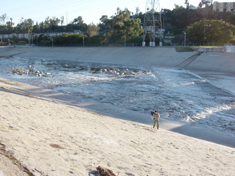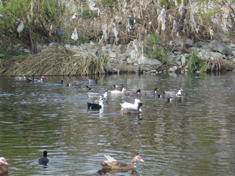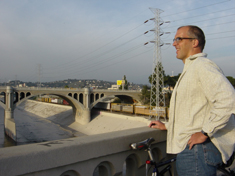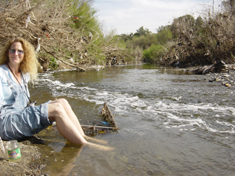Remaking the Los Angeles River
Air Date: Week of June 16, 2006

The LA River flows through the community of Atwater Village, north of downtown Los Angeles. (Photo: Ilsa Setziol)
Straightened, lined with concrete, filled with treated sewage, is there still a river in the Los Angeles River? Angelenos are saying yes, and demanding that planners and engineers go to lengths, even great lengths, to bring back a stream Los Angeles can call its own. Ilsa Setziol reports.
Transcript
CURWOOD: Since the Industrial Revolution, people have counted on the rivers to be workhorses: ferrying goods, turning the mills, and absorbing pollution flushed out of factories. So, in the past, many cities turned their backs on their foul-smelling, channelized rivers.
It would be a sorry contest, but perhaps nowhere has the neglect been greater than Los Angeles. Yes, there is a river in L.A., though you might mistake its often-dry, concrete-lined bed for another freeway. After decades of viewing the Los Angeles River as a flood control channel – and as a joke – Angelinos are working now to revive their river.
From member station KPCC in L.A., Ilsa Setziol tells about the ruin and possible rebirth of the Los Angeles River.
SETZIOL: Near Dodger stadium, a mostly Latino and Asian neighborhood called Elysian Valley backs up on the river. Joe Linton pushes his bike into tiny Rattlesnake Park.
[URBAN OUTDOOR SOUNDS; CARS IN BACKGROUND, BIRDS]
LINTON: So this pocket park was a dumping area, there were mattresses and trash. When the crews were clearing away the trash they actually found a family of rattlesnakes.

The LA River flows through the community of Atwater Village, north of downtown Los Angeles. (Photo: Ilsa Setziol)
LINTON: The strategy to date’s been kind of opportunistic, and so a lot of the reclaiming that’s been done has been planting these native trees, using the artwork, the river rocks, to begin to bring back a sense of a river – even though the river itself still needs a lot of work. But really the complexion of the river’s begun to change with these small interventions strung together.
[BIKING SOUND]
SETZIOL: Linton, who is with Friends of the Los Angeles River, slides onto his bike and heads downstream along the top of a levee toward downtown L.A. He passes rows of newly planted trees and nine mini-parks.
[URBAN SOUNDS, TRAFFIC, SIREN]
SETZIOL: Angelinos are starting to gather in these and other new parks, enjoying the river in places that used to be fenced off.
[DRUMMING]
SETZIOL: Downstream at a new 30-acre state park, a group of cyclists gathers at the end of an evening of performance art. Nelson Ornelas, Eric Crawford, and Philip Franco kick around ideas for the river.
ORNELAS: I seen this city live up. I seen it changing, there’s transformation. This used to be a railroad track. We used to come here and party, my gang. I love this transformation. This city’s got so much vibes and so much potential.
FRANCO: We’re in the desert. We need this water.
CRAWFORD: Could there ultimately be cafes on the L.A. River where you just have a glass of wine?
FRANCO: Maybe taco trucks certain parts of the day. (Laughter)
[CONVERSATION FADES; DRUMMING]
SETZIOL: In fact, many Angelinos now want a lot from this river: more parks, cleaner water, a fix for neglected neighborhoods, and a healthier inner city.
[RUNNING WATER, RIVER SOUNDS]

Plastic bags and other debris are a common sight along the LA River. (Photo: Ilsa Setziol)
[MOVING WATER]
SETZIOL: The river’s tributaries rushed out of the mountains surrounding the city, including the 9,000-foot San Gabriel Mountains. At the foot of the San Gabriels, ornithologist Kimball Garrett of the L.A. County Natural History Museum surveys a reservoir behind a large dam built for flood protection. A black-crowned Night-Heron perches in a willow, motionless, waiting out the day. Ruddy ducks, cormorants and western grebes…
[GREBE CALL]
SETZIOL: …cruise through glassy water.
[GREBE CALL]
SETZIOL: Garrett says as the L.A. River flowed into the basin and out to sea, it would weave around a broad prairie, filling up low-lying areas.
GARRETT: A lot of the sort of backwater areas that did grow up to what you really could call a riparian forest or jungle – cottonwoods, willows, vines and tangles that would go on and on and on, extensive marshlands. There were species that bred there that have completely disappeared, things like the yellow-billed Cuckoo, the long-eared owl.
[MOVING WATER]
SETZIOL: The river also created habitat for arroyo toads, red-legged frogs, and other species that have disappeared from the watershed. Even large ocean-dwelling Steelhead trout were here. Born in the mountain headwaters, they grew big and sleek in the ocean and would return to spawn, some 50 miles upstream. But as Angelinos built homes, businesses and farms in the L.A. basin, people diverted water out of the river into pipes, leaving much of it dry in the summer.
Los Angeles City Councilman Ed Reyes.
REYES: The river became essentially where you hid your gas lines, your pipelines, your power lines, your rail lines, and you let those people live there. So it became a social and economic divider. They defined it as a place in which you send those other people to the other side of the tracks.
SETZIOL: In the late 1930s, Ralph Lopez Urbina lived here. He and his pals swam in the river when it was still marshy and green. They captured pigeons roosting on the bridges. URBINA: We also did a little fishing, cause there were river minnows in the water, and there were pollywogs and frogs. And then there was the red crayfish – bright, crimson, you know – we used to like to capture them and study them and play with them. I would play hooky from school and go to the L.A. River. Really, you know. Because it was a lot more interesting. (Laughs)
SETZIOL: As Los Angeles sprawled, people built right up close to the river and on land where it sometimes flooded, so that when a record flood came in 1938, it damaged $60 million dollars in property and killed 59 people.
Enter the Army Corps of Engineers, with a plan to confine the wayward current to a concrete channel. It took 25 years, but nearly all the river's 52 miles were paved. [SOUND OF DUCKS]
SETZIOL: Still, nature persisted where it could. North of downtown, there's an eight-mile stretch where there’s no concrete on the bottom. Ducks still nest here among willow trees laden with trash. Long-legged shore birds stride alongside graffiti scrawled on the concrete bank. They dip their slender bills into treated waste-water that constitutes most of the river’s flow today. In the 1980s, a group of artists – like the taggers – saw all that concrete as a blank canvas, a place for a different vision. Poet Lewis McAdams and others founded Friends of the Los Angeles River.
McADAMS: The basic line was meeting people down by the river, and making the river a place where people gather in the central city, in the place where the city – the reason the city is here is because of the Los Angeles River. SETZIOL: They dreamt of a real river. Bureaucrats initially dismissed the idea as quixotic. But after a decade of legal and public relations efforts, their attitudes began to change. Los Angeles is now developing a new river master plan.

Joe Linton, of Friends of the Los Angeles River, looks at a stretch of the river channel in downtown LA, and one of its historic bridges. (Photo: Ilsa Setziol)
SETZIOL: Atop a levee, Joe Linton continues his ride. His dream is of jackhammers. He says they'd go a long way. LINTON: Full-scale restoration’s probably not possible. The river used to wander around, and we’ve pretty much developed it. But the truth is a lot of stretches that don’t have any real riparian habitat, that don’t have places where the water touches the earth, could be restructured and rebuilt, terraced, reconfigured. They won’t be fully natural – there will be some sort of reinforcement – but they won’t be just water running over concrete anymore. SETZIOL: But Angelinos aren’t likely to see large-scale removal of concrete in the near future. Engineers say the smooth and barren channel speeds storm water out to the ocean, so it doesn't flood. Colonel Alex Dornstauder of the U.S. Army Corp of Engineers says the channel needs to stay robust.
DORNSTAUDER: At storm level, we’re passing approximately the same amount of water as comes down the Colorado River. The elevation change from the mountains to the ocean is about the same as you’d find in the entire course of the Mississippi River. SETZIOL: That speed presents a challenge for greening the river. Fast flows will just rip out new vegetation. There’s more green on Dornstauder’s fatigues than in channel near where we're standing. He says more vegetation in the channel would slow down the water, increasing the flood risk. DORNSTAUDER: If we’re going to change the dynamics of the channel, if we’re going to not allow the velocity to flow specifically along the concrete, we’re going to have to increase the area. Or if we’re going to roughen up the surface with vegetation, it’s going to have to increase the area. SETZIOL: One solution, then, is giving the river more room. That’s possible in some places. Los Angeles plans to focus on five areas where there’s enough open space to widen the channel or make new parks.
[RIVER SOUNDS, RUNNING WATER]

Melanie Winter, of The River Project, dips her toes into the River in one of the few places where there is no concrete on the bottom. (Photo: Ilsa Setziol)
WINTER: Which it never was tasked with doing before. The ground, the dirt throughout took its share, and it’s no longer allowed to. By ordinance, every drop is supposed to fall into a concrete gutter, and hence a storm drain, and hence the Los Angeles River. SETZIOL: Melanie Winter dips her toes into the river at Sepulveda basin, a flood control area in the San Fernando Valley. With no concrete on the bottom here, the water licks at the bare earth. It swerves around willow trees, tugs at plastic bags, races through the grates of abandoned shopping carts. Winter says despite the obstacles, a major restoration is possible.
WINTER: If enough people agree and find it to be a priority for them, it’s absolutely possible.
[SOUND OF KING FISHER]
SETZIOL: A king fisher! WINTER: (blasé) Yeah, they’re here all the time.
[WING FLAPPING SOUND]
WINTER: The only reason other people haven’t made it a priority is they haven’t come down here and been surprised by a kingfisher and realized that that’s in their own backyard. SETZIOL: Winter says to ease the burden on the L.A. River, Los Angeles needs to allow more rainwater to filter into the ground instead of washing onto streets. Not just because storm water flow is so heavy, but because it gets nastier the farther it flows.
[SOUND OF FREEWAY]
NAHAI: It’s dirty because storm drains empty out into the LA River without any treatment whatsoever.

David Nahai, Chair of the Los Angeles Regional Water Quality Control Board, leads the charge to clean up the river. (Photo: Ilsa Setziol)
NAHAI: What is left on our streets goes into the storm drains, into our waterways and out to the ocean. It’s a very stark equation: pet feces; oftentimes human fecal material; to oil, grease, fertilizers, pesticides, and of course, the ubiquitous litter. SETZIOL: Nahai glares at the food wrappers and soda cans littering a levee. Every year, he says, the county hauls out enough trash to fill about 200 dump trucks.
[FREEWAY SOUNDS AND FINCH BIRDSONG]
SETZIOL: To clean up the river, the water board is setting regulations on dozens of contaminants, using a previously ignored section of the federal Clean Water Act. But there’s debate over the goal. Should a river that’s become a storm drain be held to a fishing and swimming standard? The water board says yes. But some say, why? People aren’t allowed to swim in the river anymore.
Larry Forester is vice mayor of Signal Hill. FORESTER: We prohibit entry into the river right now. I don’t think that should change. Now do I think some of the side areas could be used to develop parks, as long as we keep people out of the water? Yes.
SETZIOL: And then there are the freeways. Much of the Los Angeles River is shadowed by four of them. But to L.A. City Councilman Ed Reyes, the urban blight surrounding the river is all the more reason to transform it. REYES: This happens to be where working folks live, people of color live. We have to go to the places that has the greatest effect, that has the greatest potential to cause relief, to create healing. And I think you need to go into the areas that’s the most severe.
SETZIOL: The years of neglect – and fencing installed to keep people out – have made the Los Angeles River a good hideout for the homeless and for youth, some in and some out of trouble. CARR: This is a kind of no-man’s land down here.
SETZIOL: Netti Carr of Friends of Atwater Village walks a stretch of the River in the Latino community of south Atwater.
CARR: The LAPD, they only down here if there’s something really wrong. The homeless know it’s a very safe place for them, so they tend to congregate down here. And the gangs do, too, because they also have a safe haven. They jump over this fence and nobody can get to them, you know?
SETZIOL: Netti Carr wants to help kids stay out of trouble by making them guardians of their river. CARR: In Atwater, in central, south Atwater, we have no amenities for the youth. We don’t have a playground, we don’t have a basketball court, we don’t have anything.
[BIKE COASTING]
LINTON: It can be a real corridor through LA that’s really about pedestrians and bicycling and not about driving. SETZIOL: Continuing his ride, Joe Linton of Friends of the L.A. River scoots off his bike at another tiny park.
LINTON: This is called Steelhead Park. You can see on the fences there’s sort of a motif of a steelhead trout. Up until the 40s the river was home to steelhead. We’ll know our job is done when the steelhead return to the river.
SETZIOL: Joe Linton also stops at a confluence of a tributary. But what’s really noticeable is the confluence of the 5 & 110 freeways.
[TRAFFIC SOUNDS]
LINTON: (talking over very loud freeway noise) This is where the Spanish explorers first encountered the L.A. River, or at least first wrote about it. They found large oaks and willows and sycamores, wild roses. They described it as a lush and pleasant spot in every aspect. [MIX OF BIKING, TRAIN, AND WATER SOUNDS]
SETZIOL: Linton heads back upriver. The sun rides low, suffusing the sky with a pink glow. The Union Pacific chugs by, evening commuters whisk by, their lights flashing. Down by the river, ducks settle in for the night. Linton sees the still silhouette of a heron reflected in the flowing water. And he rides, through the slim shadows of the young sycamores atop the concrete bank. [RIVER SOUND, BIRD CALL]
SETZIOL: For Living on Earth, I’m Ilsa Setziol.
Links
Friends of the Los Angeles River
Living on Earth wants to hear from you!
Living on Earth
62 Calef Highway, Suite 212
Lee, NH 03861
Telephone: 617-287-4121
E-mail: comments@loe.org
Newsletter [Click here]
Donate to Living on Earth!
Living on Earth is an independent media program and relies entirely on contributions from listeners and institutions supporting public service. Please donate now to preserve an independent environmental voice.
NewsletterLiving on Earth offers a weekly delivery of the show's rundown to your mailbox. Sign up for our newsletter today!
 Sailors For The Sea: Be the change you want to sea.
Sailors For The Sea: Be the change you want to sea.
 The Grantham Foundation for the Protection of the Environment: Committed to protecting and improving the health of the global environment.
The Grantham Foundation for the Protection of the Environment: Committed to protecting and improving the health of the global environment.
 Contribute to Living on Earth and receive, as our gift to you, an archival print of one of Mark Seth Lender's extraordinary wildlife photographs. Follow the link to see Mark's current collection of photographs.
Contribute to Living on Earth and receive, as our gift to you, an archival print of one of Mark Seth Lender's extraordinary wildlife photographs. Follow the link to see Mark's current collection of photographs.
 Buy a signed copy of Mark Seth Lender's book Smeagull the Seagull & support Living on Earth
Buy a signed copy of Mark Seth Lender's book Smeagull the Seagull & support Living on Earth

